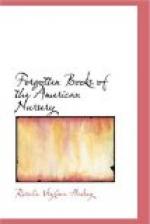To discuss in detail this class of writings is not necessary, but a glance at the story of “Clarissa” gives an instructive impression of what old-fashioned children found zestful.
“Clarissa Harlowe” in its abridged form was first published by Newbery, Senior. The book that lies before the writer was printed in seventeen hundred and seventy-two by his son, Francis Newbery. In size five by three and one-half inches, it is decked in once gay parti-colored heavy Dutch paper, with a delicate gold tracery over all. This paper binding, called by Anna Winslow “Flowery Guilt,” can no longer be found in Holland, the place of its manufacture; with sarsinet and other fascinating materials it has vanished so completely that it exists only on the faded bindings of such small books as “Clarissa.”
The narrative itself is compressed from the original seven volumes into one volume of one hundred and seventy-six closely printed pages, with several full-page copper-plate illustrations. The plot, however, gains rather than loses in this condensed form. The principal distressing situations follow so fast one upon the other that the intensity of the various episodes in the affecting history is increased by the total absence of all the “moving” letters found in the original work. The “lordly husband and father,” “the imperious son,” “the proud ambitious sister, Arabella,” all combined to force the universally beloved and unassuming Clarissa to marry the wealthy Mr. Somers, who was to be the means of “the aggrandisement of the family.” Clarissa, in this perplexing situation, yielded in a desperate mood to “the earnest entreaties of the artful Lovelace to accept the protection of the Ladies of his family.” Who these ladies were, to whom the designing Lovelace conducted the agitated heroine, is set forth in unmistakable language; and thereafter follow the treacherous behaviour exhibited by Lovelace, the various attempts to escape by the unhappy beauty, and her final exhaustion and death. An example of the style may be given in this description of the death-scene:
“Clarissa had before remarked that all would be most conveniently over in bed: The solemn, the most important moment approached, but her soul ardently aspiring after immorality [immortality was of course the author’s intention], she imagined the time moved slowly; and with great presence of mind, she gave orders in relation to her body, directing her nurse and the maid of the house, as soon as she was cold, to put her into her coffin. The Colonel [her cousin], after paying her another visit, wrote to her uncle, Mr. John Harlowe, that they might save themselves the trouble of having any further debates about reconciliation; for before they could resolve, his dear cousin would probably be no more....




